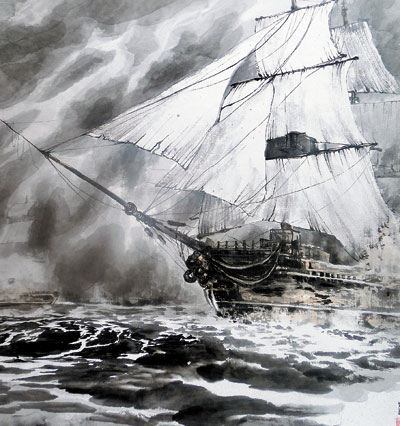
Chen Xiaochun 654789759@qq.com MANY Chinese are familiar with stories of Zheng He’s voyages to the “western oceans,” a Ming Dynasty (1368-1644) admiral’s expeditionary voyages that led his fleet and him to Southeast Asia, South Asia, Western Asia and East Africa from 1405 to 1433. But apart from these, are you familiar with other maritime-related stories of China? The naval battle painting exhibition, “The Era of the Sailboat: A 2,000-year History of the Maritime Silk Road,” organized by the China National Arts Fund, the Culture, Sports and Tourism Administration of Shenzhen Municipality and Shenzhen University, offers a glimpse into the maritime history of China. The exhibition, inaugurated last Saturday at Shenzhen University, presents to the public a feast of ancient naval battle paintings of great historic value from the Yuan Dynasty (1279-1368) to the Qing Dynasty (1644-1911). “Our organizing committee has aligned the maritime figures and sailboats starting from the Warring States Period (475-221 B.C.) all the way to the present Chinese aircraft carrier Liaoning in chronological order,” Ge Yang, head of the Department of Exhibition and Education of the Ocean Art Research Center of Shenzhen University, told the Shenzhen Daily. The exhibition, featuring many important maritime figures in Chinese history, has some 150 naval battle paintings and over 40 ship models on show. For example, the figure in the first painting of the exhibition, Zouzi, who was born in about 324 B.C., was the first one that put forward the ocean theory. The research team of the Ocean Art Research Center of Shenzhen University spent three years traveling through different countries including Japan, Britain, Germany, Belgium, the Netherlands, Italy, France and multiple coastal cities in China to collect naval battle paintings of different eras and other ocean-themed paintings and historical documents. “Now our government wants to emphasize the ‘maritime power’ strategy. As we look back, we find that China also boasts a long and glorious maritime history,” said renowned oceanographer Liang Erping, one of the curators of the exhibition who is also the academic director of the Ocean Art Research Center and deputy editor-in-chief of the Shenzhen Evening News. “Starting from the era when Xu Fu in the Qin Dynasty (221-206 B.C.) traveled the ocean to fetch ‘panacea,’ the rulers of China have started paying attention to exploration of the ocean,” said Liang. A record in “Book of Han: Annals of Geography” said that in the Han Dynasty (206 B.C.-A.D. 220), Chinese people sailed across the Gulf of Beibu and reached Sri Lanka and the Indian coasts, which represents the beginning of China’s maritime trade. “Later, Zheng He’s voyages to the western oceans, not only mark friendly exchanges between China and the countries along the route but also leave us the valuable Nautical Charts of Zheng He (an atlas which was charted as a record of the first six, some say seven, voyages by Zheng and other Chinese pioneers before him),” Liang proudly said. Zhang Yanxin, another curator of the exhibition and dean of the Ocean Art Research Center of Shenzhen University, believed that traditionally the Chinese emperors put more emphasis on land rather than sea, which could be proved by the contents of ancient paintings. “There were many artists specializing in figure paintings, bird-and-flower paintings or landscape paintings but few specialized in paintings of the ocean, sailboats, maritime figures or other related topics. On the contrary, the Netherlands and Russia have plenty of ocean-themed paintings whose quantity leaves China way behind,” Zhang said. “We hope that, through this exhibition, on the one hand, the public can get to know more about the maritime navigation history of China, and on the other hand, the exhibition, which gathered artists to create on the theme of ocean, can help bring together artists who share the same interest in this topic.” Dates: Oct. 22-31 Venue: Art Gallery of Shenzhen University (深圳大学美术馆) Metro: Luobao Line, Shenzhen University Station (深大站), Exit A2 | 
